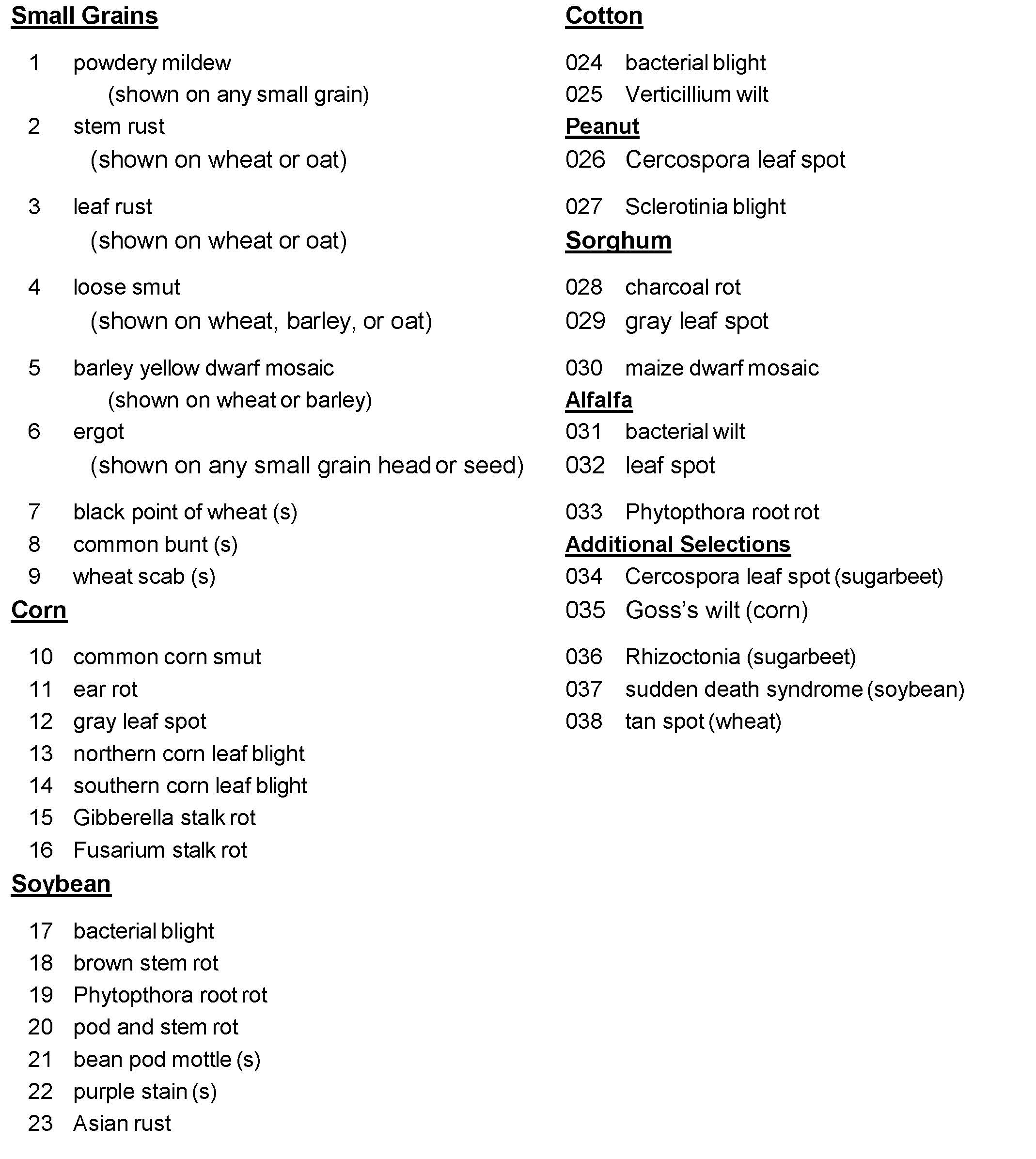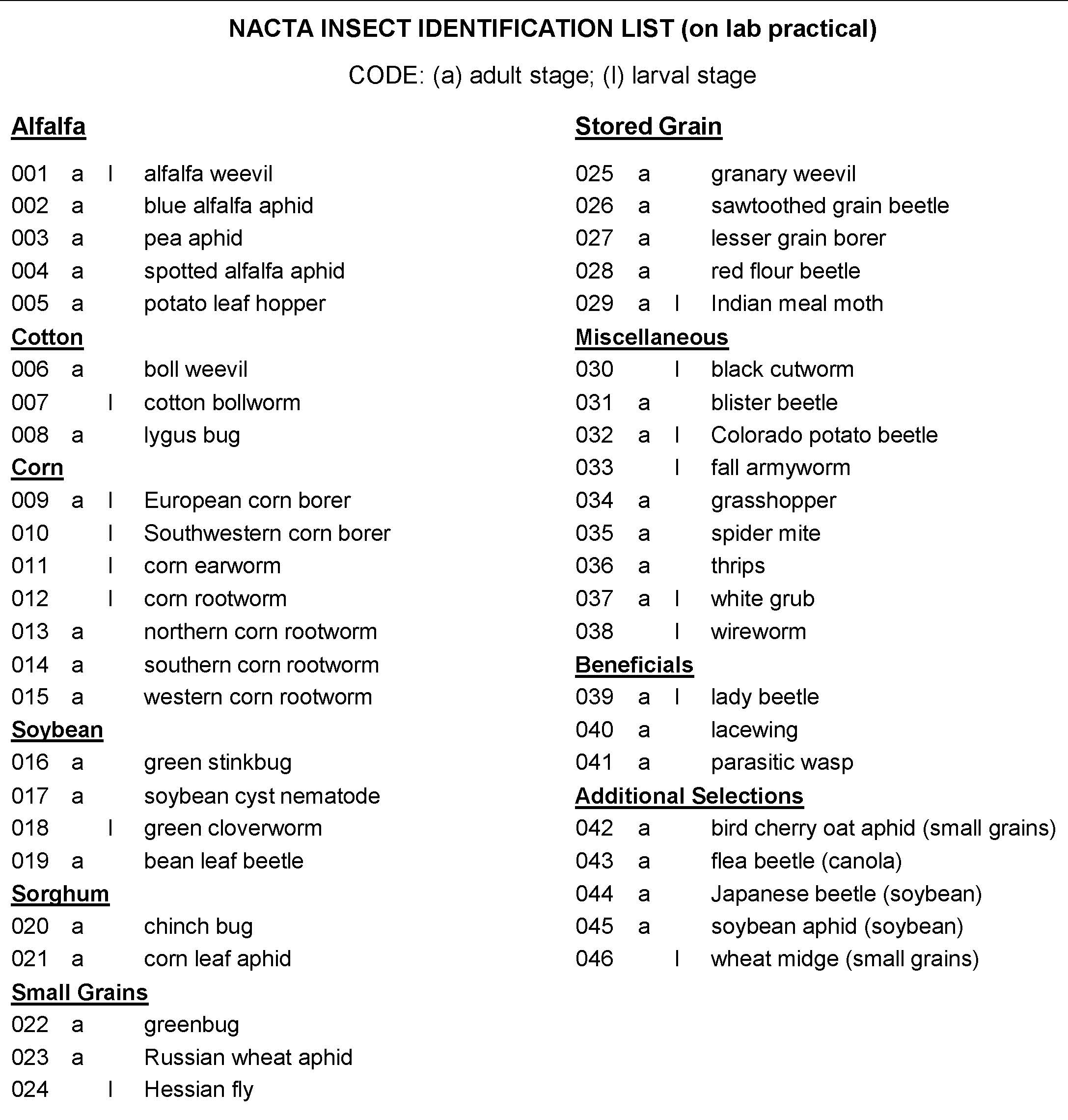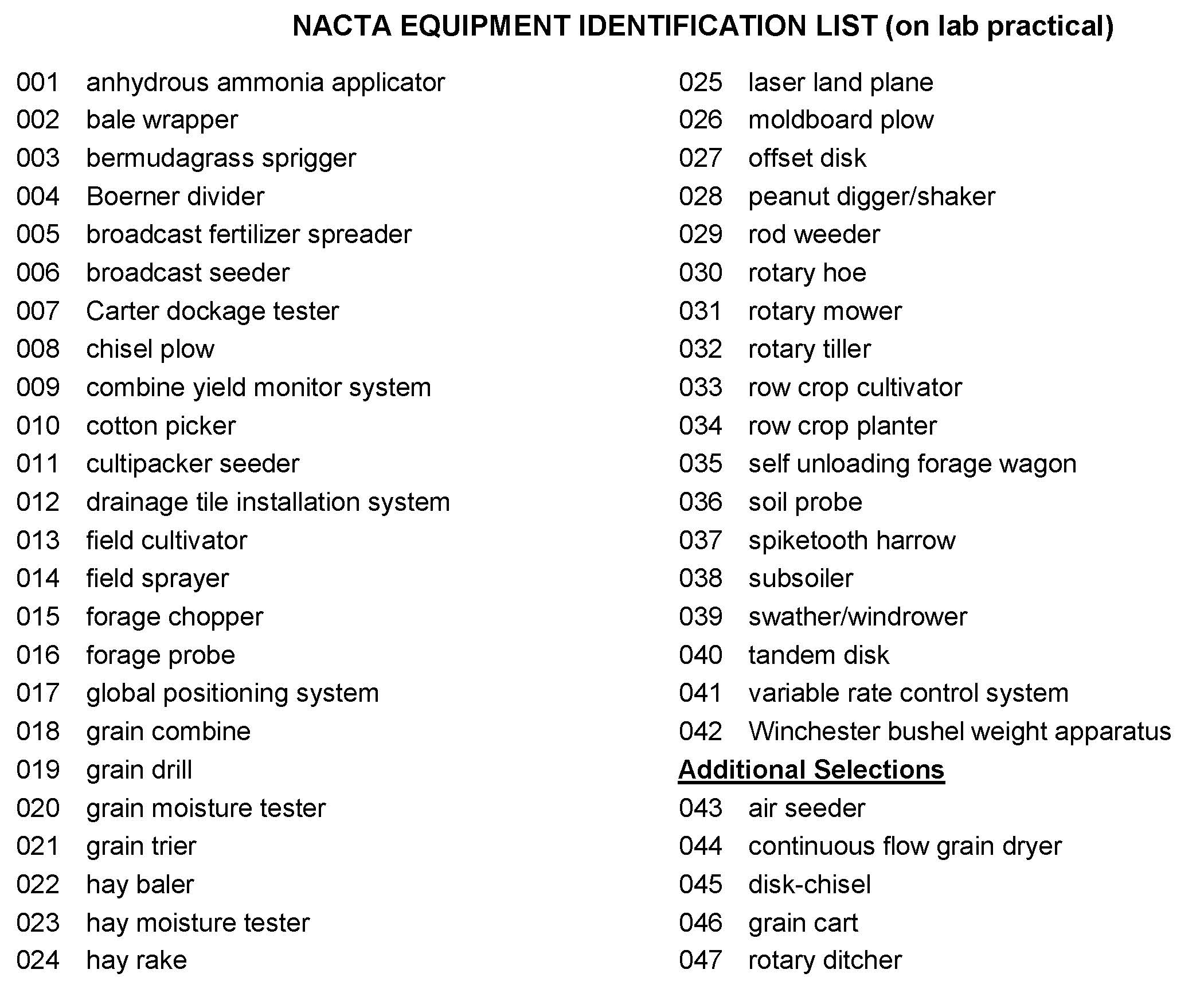Crops
|
Download a copy:
|
Teams and Eligibility
CONTEST ADMINISTRATION
The superintendents will be responsible for preparation of all contest materials, setting up the contest, providing the official keys for scoring, and overseeing the contest operation and scoring of papers. Room supervisors will be assigned to each of the four sections of the contest and will be responsible for the operation and conduct of each section. Coaches may be asked to help grade the math practical during and after the contest.
- Tie Breakers. Ties for both teams and individual contestants will be broken using the following contest sections:
a. First – lab practical scores
b. Second – plant and seed identification scores
c. Third – math practical scores
d. Fourth – agronomic quiz scores
2. Announcements made at the coaches meeting or on the contest day will take precedent over the previously published rules.
The contest will be divided into four areas with 600 total points as follows:
- Agronomic Quiz (150 points)
- Math Practical (150 points)
- Lab Practical (150 points)
- Plant and Seed Identification (150 points)
One hour will be allowed for completion of each section. Additional descriptions and specific rules for each section of the contest follow and will be considered official for the contest.
AGRONOMIC QUIZ
This section will consist of 75 written multiple-choice exam questions worth 2 points each for a total of 150 points. Both general and specific questions will be asked on production of major US grain and forage crops. The International Certified Crop Adviser (ICCA) Performance Objectives will provide an excellent outline of potential topics. They are available from the American Society of Agronomy, 5585 Guilford Road, Madison, WI 53711-5801 (608-273-8080) or online at: https://www.certifiedcropadviser.org/exams/icca-performance-objectives
- Crop production statistics (major world and S. crops) and distribution of US crops
- Crop classification terms (botanical, growth habit, crop utilization, )
- Crop physiology, growth, and development
- Crop quality and quality evaluation, including typical levels for quality factors in various grain and forage crops
- Plant morphology and anatomy
- Plant breeding and genetics, including biotechnology and genetic engineering tools and applications
- Seed industry/technology (seed quality, certification, testing, processing, treatment, intellectual property rights, )
- Planting (cultivar selection, seeding equipment, planting practices, seeding dates, replanting decisions, )
- Pest problems and pest control (insects, diseases, and weeds, biology/life cycle of major crop pests)
- Pest management alternatives (IPM principles, pest scouting and monitoring, role of beneficial insects, )
- Pesticide use (pesticide stewardship, safety, restrictions, formulations, trade/common names of major pesticides)
- Harvesting and storage of grain and forage crops and crop products
- Management of forage crops, including harvest factors and effects on forage quality
- Cropping systems and crop rotations
- Crop environment (light, temperature, and moisture effects on plants)
- Basic soil properties (physical, chemical, and biological)
- Soil fertility (nutrient availability, nutrient movement, plant needs for nutrients, soil pH, organic matter, )
- Nutrient management (soil testing, soil test reports/recommendations, fertilizers and fertilization, liming, )
- Soil water management (irrigation, drainage, erosion, leaching, evapotranspiration, conservation, )
- Tillage and residue management (tillage systems, seedbed preparation, tillage tool selection, )
- Site specific management concepts (GPS, GIS, VRT, grid sampling, field mapping, sensing technology)
- Weather and climatic effects on crop production and management decisions
- Biofuels and biomass production for bioenergy
- Carbon management in agriculture (greenhouse gases, carbon sequestration, carbon credits, global warming)
MATH PRACTICAL
This section will include mathematical problems related to agronomy. It will be scored on the basis of 150 total points. Answers must be rounded off and given in correct units as specified in the problem. Critical information will be given except for commonly known conversion factors. Possible types of problems are listed below:
- Area conversion calculations (Estimate per acre yield from harvest strips or small plots; Calculate areas and yields from irregularly shaped fields; Area covered and time required for given capacity and delivery rate of fertilizer/chemical applicator; Time to complete tillage/harvest operation given area of field, width of equipment, and speed of travel; Obtaining material and cost estimates for fencing materials for given field size,)
- Pesticide application (Calibrate broadcast or band application given number of nozzles, nozzle spacing, output from one or more nozzles, and distance traveled or intended speed of travel; Find amount of chemical formulation to add to a spray tank to meet product or active ingredient label recommendations given tank size and delivery rate; Calculate costs of pesticide application, )
- Fertilizer/lime application (Spreader calibration given amount delivered in a distance traveled or by turning the drive wheel; Fertilizer application rates given carrier analysis and recommended rates in elemental or oxide form or replacement of nutrients removed by the crop; Prepare bulk blends from given rates and available carriers; Calculate costs of fertilizer/lime application; Compare costs of different fertilizers/lime sources)
- Seeding/Planting (Calibration of row planter or grain drill given amount of seed delivered in a distance traveled or by turning the drive wheel a certain number of revolutions; Seeding rates, plant population, and percent seed emergence calculations; Adjusting seeding rates and comparing costs based on PLS)
- Volume calculations (tank capacity, storage volume for hay, grain bin, or silo)
- Unit conversions (English to metric units and vice versa)
- Concentration (ppm, %)
- Harvest (estimating harvest losses, harvest speed, area covered)
- Irrigation (application rate for given PSI and GPM, convert gallons to acre-inches)
- Labor requirements (hours/acre)
- Pasture carrying capacity (stocking rates based on animal units)
- Soil erosion loss equation
- Soil physical properties (bulk density, % soil moisture, water retention in profile):
- Plant breeding (heritability, % homozygosity, expected genotypic and phenotypic ratios from a cross)
- Water usage (day, season, species differences)
- Identify common crop diseases and disease symptoms (see attached list – copy of list will be provided during contest)
- Identify common crop insects and insect damage (see attached list – copy of list will be provided during contest)
- Identify common field machinery and other agronomic equipment (see attached list – copy of list will be provided during contest)
- Recognize classes of pedigreed seed from standard seed tags and interpret information from a seed bag (germination, purity, seed size, noxious weeds, variety or hybrid identification, genetically modified traits, refuge requirements, treatments applied, recommended seeding rates, planter adjustments, )
- Write the commercial grade and grade determining factors for market grain samples given various quality factors and official FGIS grain standards tables
- Identify specific plant and seed structures, crop growth stages, or developmental characteristics on fresh or pressed plant samples
- Recognize common nutrient deficiency symptoms (N, P, K, S, Fe) on both dicot and grass crops
- Recognize common herbicide injury symptoms on weeds and crops
- Use a soil textural triangle to name soil textural class
- Determine soil texture by feel, distinguish different types of soil structure, relate soil color to soil properties
- Interpret information found in a soil survey or on a soil test report
- Recognize common fertilizer carriers (major nutrient supplied, typical analysis, common name)
- Interpret information on a fertilizer bag or pesticide label
- Recognize common pesticide formulations and their standard abbreviations
- Determine proper sprayer nozzle tip size and type, screens, pressure, for pesticide applications
- Identify and explain the purpose of items such as ag lime, inoculum, seed treatments, soil amendments,
- Identify stored or processed crop products and common livestock feed ingredients made from crops (silage as to type, hay as to type, alfalfa pellets and cubes, soybean meal, cottonseed meal and hulls, wheat bran, corn meal, beet pulp, dried distillers grains, flaked or ground grains, )
- Match various food and/or industrial products with the crops (or classes of a crop) from which they are
- Evaluate crop quality by ranking two or more samples of hay, silage, seed, or cotton.
- Interpret data from tables or graphs (analyze a variety trial based on the LSD mean comparison statistic, select the proper spray nozzle tip for given conditions from a
- manufacturer’s spraying equipment manual, read a calibration nomograph for a sprayer or planter, interpret crop yield response to different input levels, determine economic threshold from pest counts vs. yield response given control costs, etc.)
- Evaluate various crop production problems from photos, illustrations, or
- Identify or describe common crop production and soil management practices from photos or slides.
- A total of 75 specimens will be identified in a one-hour time Each sample will be worth 2 points for a total of 150 points. Contestants may move at will among unoccupied stations during the contest, but must stand directly in front of the specimen being viewed and only one contestant may examine a specimen at a time.
- Crop and weed plants will be shown either as fresh or dried and pressed All seed samples will be mature. Seed may be shown either hulled, or where typical, within surrounding hulls, burs or pods (e.g. wild buckwheat, peanut, Korean lespedeza, rice, etc.).
- Crop and weed identification materials will be selected from the attached identification list. Items are marked with a (p) for plants that may be shown in the flowering to mature plant stage, (v) for plants that may be shown in the vegetative stage, and (s) if seed identification is required. (The final ten plants and/or seeds on the list were added by the host )
- Plants and seeds will be identified by common name as given on the official identification list provided each contestant. Contestants must fill in bubbles corresponding to the identification code for the specimen as given on the list
- Hand magnifying lenses will be allowed.
- Sample specimens may not be moved from their stations. Live plant specimens may be touched carefully to aid in identification, but must not be broken or damaged by the contestant or disqualification may result. Dried, pressed plant specimens cannot be touched. Seeds may be rearranged in their place but may not be removed from their container.
PLANT AND SEED IDENTIFICATION LIST
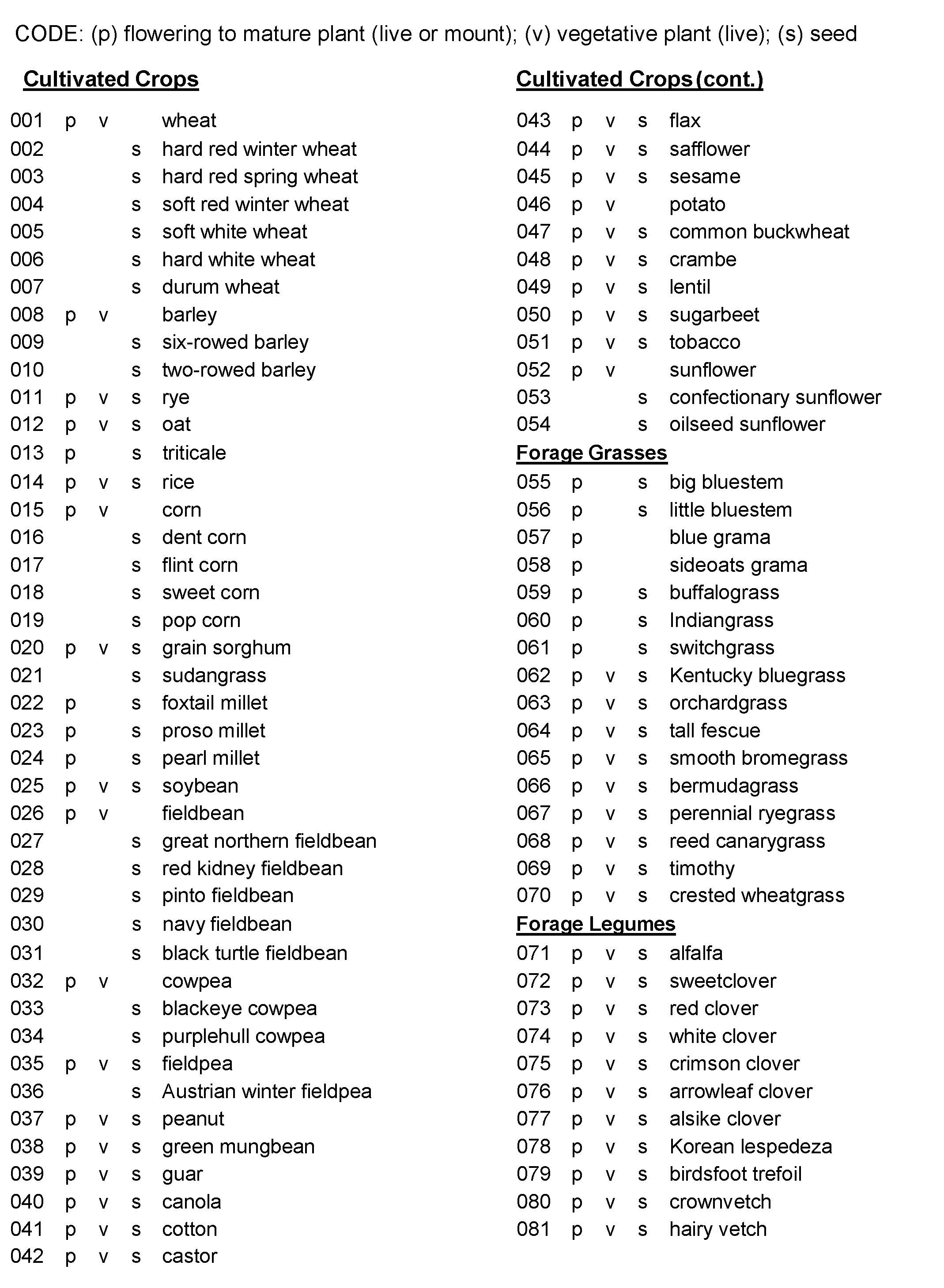
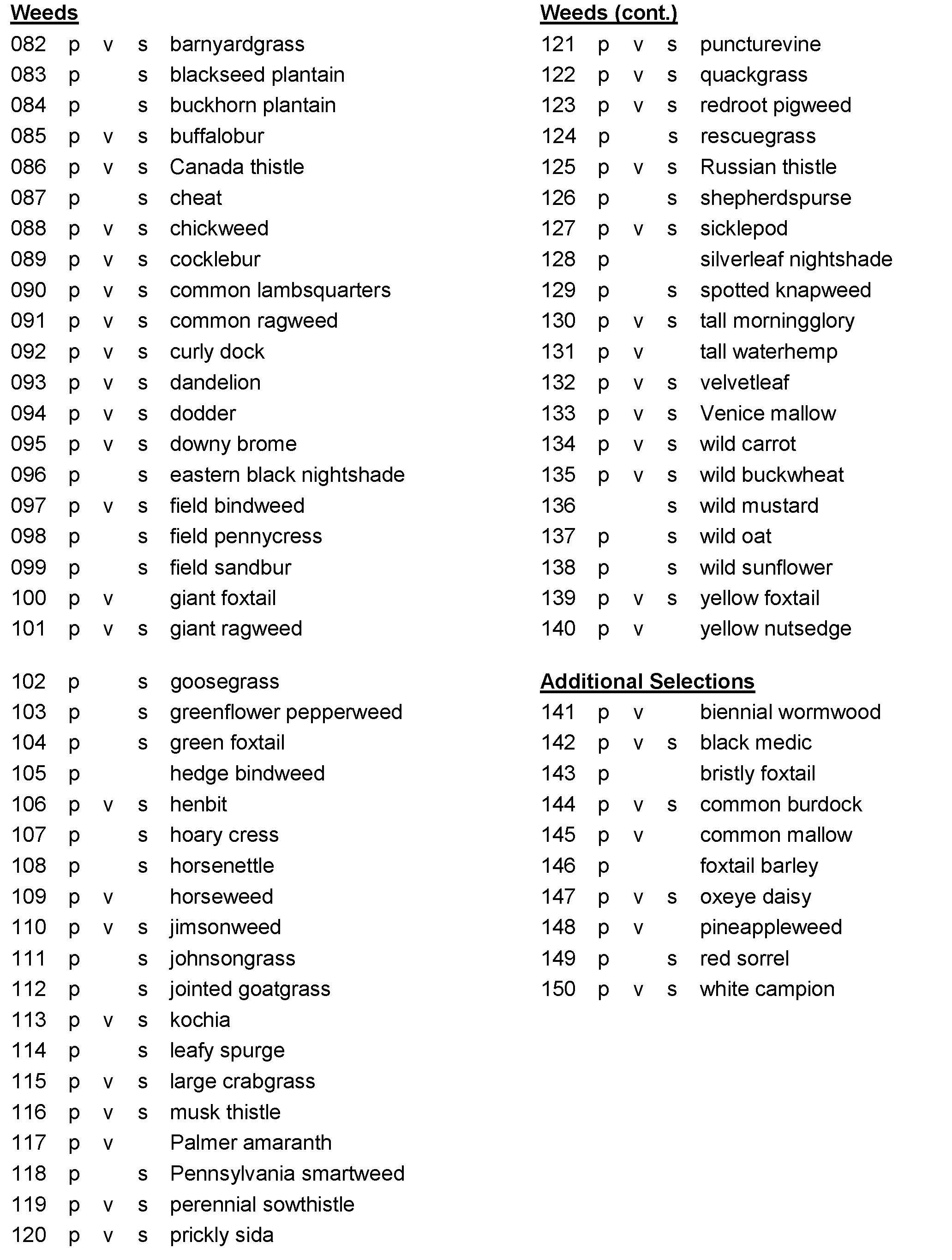
CROP DISEASE IDENTIFICATION LIST (on lab practical)
